

Written by: David
“I feel,I am EthereumA fool of some use value from the Foundation.”
OctoberOn the 19th, a letter was written onThe open letter from half a year ago was posted on Twitter, and the words in it quickly ignited discussions in the encryption community.

The person who wrote the letter was not some fringe Ethereum troll, but Péter Szilágyi:
The former head of the Geth client who once maintained more than 60% of Ethereum node operations, and a core developer who has worked in this ecosystem for a full 9 years.
Is there a familiar feeling?
If you’ve followed Ethereum long enough, you’ll notice this scenario playing out every few months:
Criticism of the Foundation (EF) suddenly erupted, the community got into heated discussions, Vitalik responded, and then everything went quiet until the next explosion.
2022 is about centralization concerns after Merge, 2023 is about researchers’ conflicts of interest, and 2024 is about the fragmentation of L2.
Now the powder keg has been ignited by an old letter.
The description of “useful fool” is like a knife, piercing a certain long-maintained illusion, and also hurting the hearts of many contributors to the Ethereum ecosystem.
Core contributors who rarely criticize publicly on weekdays, including Polygon founder Sandeep and DeFi father AC, stood up one after another; the message conveyed can be summarized in one sentence:
We have been let down.
And the specific questions they asked cut to the chase: Where did the money go?Why do the most loyal people get the least?Who really controls the direction of Ethereum?
These questions are actually commonplace, but when they are spoken from the mouths of Ethereum’s core contributors, the situation and weight may be completely different.
We can first read this letter carefully to see what a technical leader who has been working in Ethereum for 9 years has gone through before he would describe himself as a fool.
Nine years of loyalty, one disappointment
When Péter Szilágyi writes this letter on May 22, 2024, he may be in the midst of a painful cycle.
The letter begins with a sincere heart.Péter said that he has become increasingly confused and painful about Ethereum and his role in the foundation over the years.He was trying to clear his mind, which led to this letter.
The entire content of the letter reflects the numerous problems a loyal developer has seen regarding Ethereum and the Foundation during his career.
-
Problem 1: He is called a leader, but he is actually a fool who is being used
Péter said he felt he was being used as a “useful fool” by the foundation.
He explained that whenever there is a controversy within Ethereum, such as a conflict of interest arising from a researcher receiving money from an external company, or a new proposal that is clearly biased towards a specific interest group, the foundation will ask him, the “thorn”, to stand up and oppose it.
Looking through Péter’s previous tweets, it seems that they are indeed a bit criticizing and outspoken. He often discusses some issues within the Ethereum ecosystem; and the content revealed in this long letter means that these remarks are more like a performance to cater to the collective interests of the Ethereum Foundation.
In this way, the foundation can declare to the outside world: “Look, we are very democratic, and we also have different voices internally.”
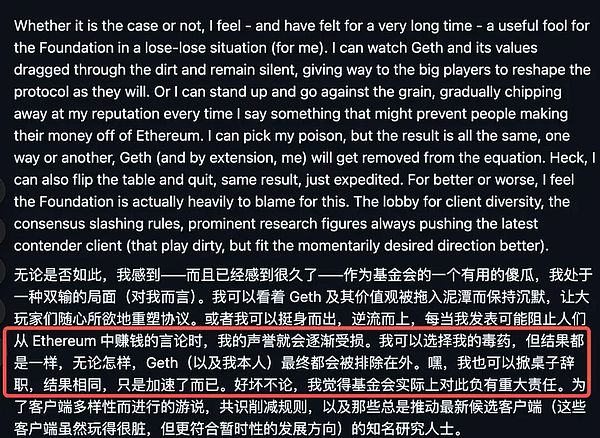
But the problem is, every time Péter stands up to challenge those with power or connections, his credibility suffers.Those who support the other side will attack him, saying that he hinders progress.Over time, he and the Geth team became problem makers.
“I can choose to remain silent and watch Ethereum’s values being trampled upon; or speak out and gradually destroy my reputation.” He wrote, “Either choice, the result is the same – Geth will be marginalized and I will be excluded.”
-
Question 2: 6The annual salary is only60Ten thousand, high effort and low return
In the first 6 years of working in Ethereum (2015-2021), Péter received a total of $625,000.Note, this is a 6-year total, pre-tax, without any equity or incentives.The average is about $100,000 per year.
During the same period, the market value of ETH rose from 0 to $450 billion.
As the person responsible for maintaining the entire network’s most critical infrastructure, Péter may even be paid less than a freshly graduated programmer in Silicon Valley.
He mentioned that other departments of the foundation, such as operations, DevOps, and even some researchers, have lower salaries.
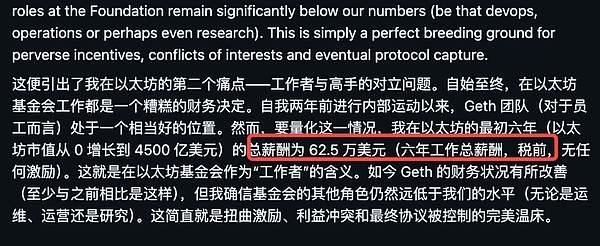
Why is this happening?Péter quotes Vitalik as saying: “If someone doesn’t complain that the salary is too low, it means the salary is too high.”
To settle down and engage in technology without caring too much about rewards is indeed the ideal image of some technology geeks and cypherpunks.But the problem is that a long-term culture of low pay can have negative consequences.
Those who really care about the development of the protocol are forced to look for compensation outside because they cannot get a good salary within Ethereum.
Various conflicts of interest arise: researchers serve as consultants for external projects, and core developers receive sponsorship privately.
Péter bluntly said: “Almost all the early employees of the foundation have left long ago, because that is the only reasonable way to obtain compensation commensurate with the value created.”
-
Question 3: Vitalikand his circle
The most poignant part of the letter is the analysis of the power structure of Ethereum.
Péter admitted that he had great respect for Vitalik personally, but pointed out the fact that:
Whether Vitalik wants it or not, he is unilaterally determining the direction of Ethereum.Wherever Vitalik directs his attention, there are resources;
Whatever project he invests in will succeed;
Whatever technical route he approves of becomes mainstream.
Even worse, aroundVitalikformed a “5-10“People’s ruling elite.” These people invest in each other, serve as advisors to each other, and control the distribution of ecological resources.
New projects no longer do public fundraising, but go directly to this5-10personal.Getting their investment is equivalent to getting a ticket to success.

“If you can get Bankless [a well-known podcaster] to invest, they will praise you on the show. If you can get foundation researchers to serve as advisors, you can reduce technical resistance.”
This has a familiar upward management flavor in the domestic workplace environment. The key to success is not technology or innovation, but getting the few people around Vitalik.
-
Question 4: Idealism is the saddest thing
By the end of the letter, Péter’s tone changes from anger to sadness.He said that he has turned down countless high-paying offers over the years because he believes in the ideals of Ethereum.
But now the entire ecosystem is saying “it’s just business.”He couldn’t accept this mentality, but he couldn’t see a way out.
“I feel like in the grand scheme of Ethereum, Geth is seen as a problem and I’m the center of the problem.”
This letter was written in May 2024.A year later, in June 2025, Péter left the Ethereum Foundation.He reportedly rejected a $5 million offer from the foundation to spin Geth off as a private company.
He chose to leave completely rather than turn his ideal into a business.
Chain reaction, big boss speaks out
Less than 24 hours after Péter’s letter was made public, Polygon founder Sandeep Nailwal couldn’t sit still and expressed his feelings by quoting Péter’s post.
Polygon is one of the largest Layer 2 projects on Ethereum, processing a large number of transactions and hosting numerous applications including the prediction market Polymarket.
It can be said that Polygon has made a huge contribution to the expansion of Ethereum.
But Sandeep said,The Ethereum community never really embraced Polygon.
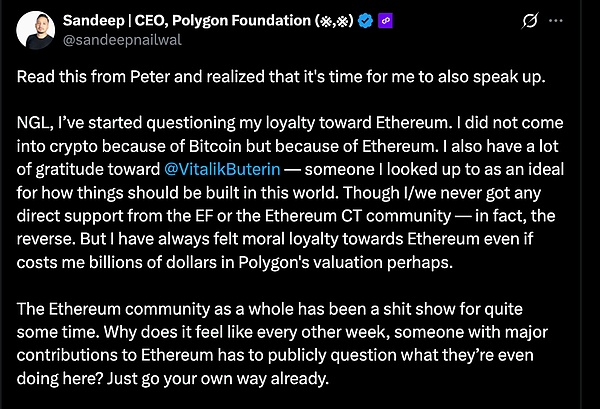
There’s a strange double standard in the market, he writes.“When Polymarket succeeded, the media said it was a ‘win for Ethereum.’ But Polygon itself? Not Ethereum.”
This is not just a matter of status, but a loss of real money.
Sandeep pointed out more bluntly that if Polygon declares itself to be an independent L1 instead of Ethereum’s L2, the valuation may immediately increase by 2-5 times.
For example, the market value of Hedera Hashgraph, a relatively niche L1 project, exceeds the sum of the four major L2 projects: Polygon, Arbitrum, Optimism and Scroll.
As for why not moving to L1, Sandeep said it was due toMoral loyalty to Ethereum, even if this loyalty may cost oneself billions of dollars in valuation.
But what does this loyalty pay for?
There are always people in the community saying that Polygon is not a true L2.Growth statistics website GrowthPie declined to include Polygon’s data.Investors don’t count Polygon in their “Ethereum ecosystem” portfolios.
Sandeep’s original post contained a particularly heart-wrenching rhetorical question:
“Why are Ethereum contributors questioning themselves every week?”
He mentioned the story of his friend Akshay.Akshay was originally inclined to support Polygon, but was disgusted by the Ethereum community’s approach of cracking down on successful projects and promoting “political correctness.”Eventually he took his talents to Solana, where he helped build the empire it has today.
Even Polygon’s shareholders are questioning his decision-making, thinking that you have a fiduciary duty to Polygon, why should you sacrifice the value of the company for so-called loyalty?
Also speaking out was DeFi legend Andre Cronje.
Andre’s post was relatively short but sharp:
“I’m confused. Who exactly is EF paying/supporting? When I built on ETH, I burned over 700 ETH just deploying the contracts and infrastructure. I tried contacting EF, never responded,NoBDContact me, no funding, zero support, not even a forward.”
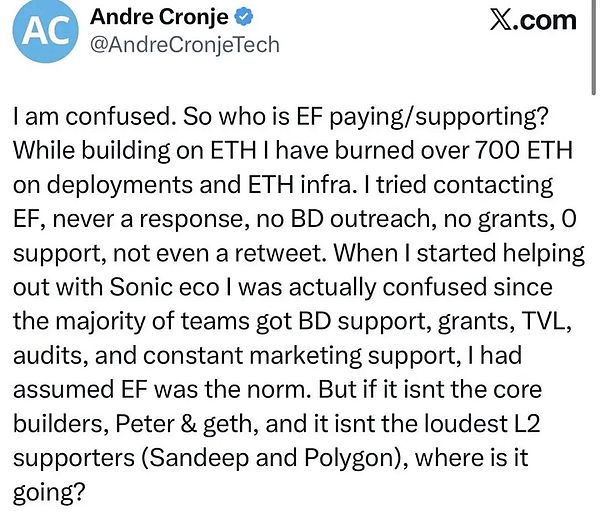
700 ETH is about $2.66 million at current prices.These are costs Andre pays out of his own pocket.
What’s even more ironic is that when AC started to help the Sonic ecosystem, they were surprised to find that most teams received continued support from BD in terms of support, funding, liquidity, and auditing.
Then, this soul torture became even more heartbreaking:
“If the money isn’t going to the core builders Peter and Geth, and it’s not going to the loudest L2 backers Sandeep and Polygon, then where is the money going?”
Vitalik responded, avoiding the truth and turning to fiction.
Faced with these doubts, Vitalik responded to Sandeep’s remarks on October 21.His reply was very long and mainly included:
-
Polygon’s contributions are listed in detail (hosting Polymarket, advancing ZK technology, etc.)
-
Praise Sandeep for his philanthropy (donating medical resources to India)
-
Thanks to Sandeep for returning $190 million in SHIB token proceeds
-
It is recommended that Polygon be upgraded with the latest ZK technology
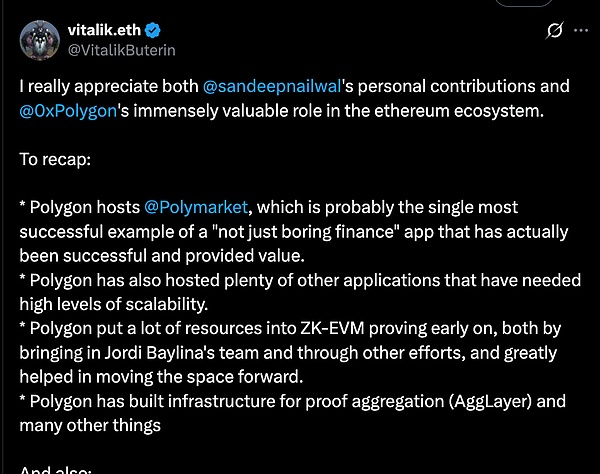
But after reading it carefully, you will find that Vitalik did not mention a word about three core issues: low salary, opaque funding, and small circles of power.
This answer is not what the question was asked, and may be an answer in itself.
These responses, taken together, point to a truth that everyone can see, but no one wants to tell: There is a serious problem with the resource allocation of Ethereum.
The most committed contributors receive little support, while those who are good at “playing the game” receive significant resources.The foundation sold over $200 million in ETH in 2025, but the money clearly didn’t go to those actually building the protocol.
Ethereum’s biggest enemy is the Ethereum Foundation
The furore sparked by Péter’s letter is likely to be covered by new headlines in two weeks, but the issues it reveals will not disappear.
In fact, this collective outcry against the Ethereum Foundation happens every few months.
For current Ethereum, its biggest enemy is actually not other chains such as Solana, but the Ethereum Foundation.
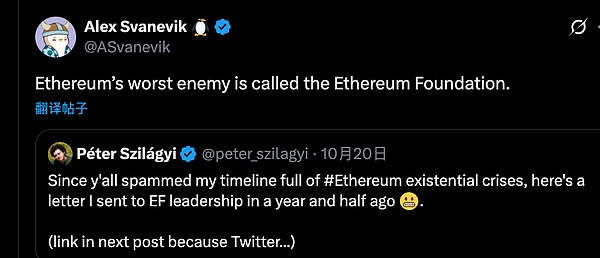
Ethereum has grown from a geek project into an ecosystem worth hundreds of billions of dollars, but its governance structure and culture are still in its early stages.
In Péter’s words, the foundation is still using “subtractive thinking” to manage a vast system that requires “additive thinking.”
The deeper reason may be that Ethereum has fallen into a typical big company disease.
Problems that startups will face when they grow large, such as bureaucracy, factional fighting, and stagnant innovation, are all common in Ethereum.
The difference is that traditional companies can respond through equity incentives and management reforms.However, as a decentralized project, Ethereum cannot admit that it is centralized, nor can it be truly decentralized.
So the core contradiction we see is: it must maintain the appearance of decentralization, but its actual operation is highly dependent on centralized decision-making.
Vitalik’s existence epitomizes this contradiction.
On the one hand, the community needs his vision and leadership; on the other hand, his very existence denies decentralization.
This creates a unique “decentralized little theater”,Everyone is performing decentralization, but everyone knows where the real power lies.
The cost of such a performance is enormous.
As Sandeep pointed out, the Ethereum community’s superficial egalitarianism, but actual small-circle control, is more hypocritical than pure capitalism.
At least on Solana or other centralized chains, the rules of the game are clear.
Now, the ball is in Vitalik and the Foundation’s court.Their choice is not only about Ethereum, but also about the direction of the entire crypto movement.Should we continue to maintain the decentralized theater, or face the reality bravely?
Time will tell.But what is certain is that those “useful fools” like Peter will not be silent forever.
The next outbreak may be more than just a letter.






